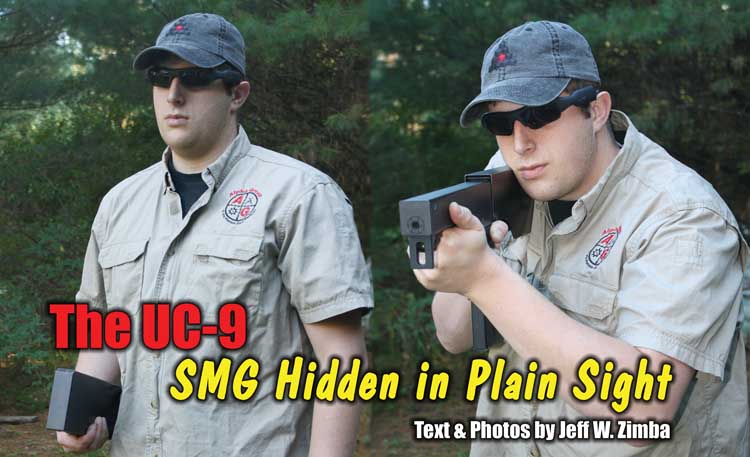
It has been over 25 years since congress passed the law making newly manufactured machine guns for individual ownership illegal. In this time we have seen many new designs that are out of legal reach for most of us, while interest in NFA ownership has steadily risen. The ban that put a cap on the number of transferable machine guns still looms over us, but thanks to the creative ingenuity that so many firearms enthusiasts and entrepreneurs possess we are still occasionally surprised by upgrades and modifications. An event ever rarer is when a little known example of legal firearms registered prior to 1986 surfaces and is made available for the first time. It is almost unheard of after all this time for a truly new machine gun to be available, and in numbers greater than a few tool-room prototypes. Thanks to the ingenuity of Utah Conner of Pearl Manufacturing and the relentless desire of Michael Shyne of M6 Management Corporation to bring Conner’s 1981 concept and creation to life, we are proud to introduce the NEW, fully transferable, UC-9 Under Cover Submachine Gun.
In The Beginning
Originally conceived and designed in the early days as the Model 21 and later re-designated as the UC-9 (Under Cover – 9mm), Utah Conner had an idea for a concealable firearm that people who needed the firepower afforded by a submachine gun could carry in plain sight. Completely unknown to him there was a similar, parallel project being developed by Francis Warin and Eugene Stoner at Ares Incorporated called the Ares FMG (Folding Machine Gun). It was also being designed as an undercover submachine gun and was dubbed a “businessman’s personal defense weapon.” While there were many similarities in the design there were also several differences. It was close enough in timeline and design to still cause confusion about who designed what, to this day. Francis Warin and Utah Conner finally met in the mid 1980s and were both amazed at the similarities in their respective systems and the original, foreign guns that inspired both men including the French 9mm Hotchkiss folding SMG, the French CR39 carbine and the MAT49. While the external shape was similar, the firing mechanism was different and the Conner gun had more accessories that made it look more like a radio available at the time including an external, telescoping antenna and carry handle.
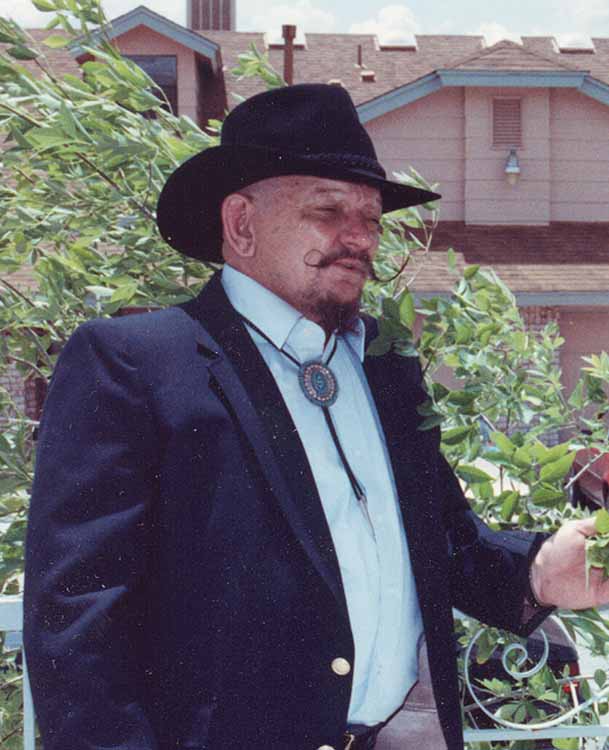
During the design phase of the early 1980s Conner partnered up with Tim Bixler of South Central Research Company (SCRC) and the production version of the Model 21 was put into motion. Very few Model 21s were completed prior to the 1986 congressional manufacturing ban and the project was put on hold for several years.
Enter M6 Management Corporation
At a machine gun shoot in New Mexico, Michael Shyne of M6 Management Corporation observed an individual demonstrating a Swiss Model 57 assault rifle he had converted from the original 7.5 Swiss round to fire the much more common 7.62×51 NATO round. During this demonstration the shooter boasted of the low recoil of the Swiss design and in order to make his point he emptied an entire 20-round magazine with the stock of the rifle rested against his groin. Having made an immediate and lasting impression already, this shooter walked the line with a rectangular brown box carried by a strap over his shoulder. Shyne watched in amazement as the man with the brown box turned to the firing line, grabbed the straps and in a quick motion the box transformed into a submachine gun sending rounds down range. It was at that moment that Shyne introduced himself to Utah Conner. Conner let him examine and fire this unique piece and introduced it as the UC-9. Conner told Shyne he had manufactured and registered about 100 receivers prior to the 1986 machine gun ban but these fully transferable machine guns had yet to be completed. Shyne immediately gained interest in the project and tried unsuccessfully, numerous times, to purchase at least one UC-9, but could never get Conner to even mention a price.
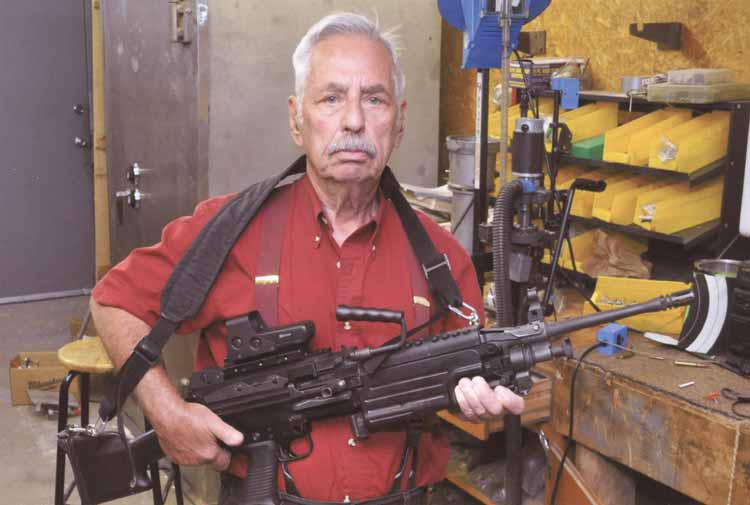
Every few years Shyne would track Conner down and talk about the UC-9 but could never get any interest in selling any, only confirming that he still had them all and had no interest in selling them. After trying everything he could, Shyne offered Conner a deal he thought could not be refused. Shyne offered to take possession of all the unfinished receivers, complete them all, and keep only half. Conner’s response was simply, “Michael, you don’t know how much work is involved.” No sale again.
Sadly, after several years of talking with Conner about the UC-9 project, Shyne discovered that Utah Conner had passed away. The project, it seemed, would pass away with him.
A New Beginning
A few more years went by and Shyne heard that before Conner died he gave the receivers to a close friend. When this friend was tracked down and contacted he revealed he had 76 receivers remaining and while he had an original goal of completing the project, none were finished and only a few parts were made from CAD drawings he started based on Conner’s original pencil and paper notes. He was not opposed to talking about selling the project.
Shyne called on the experience of long time friend John Mathis, a retired engineer from the National Aeronautics and Space Administration and fellow Emma-Gee. They took a trip to look at the project and were delighted to see the brown, complete UC-9 serial number 2 with all the parts. It looked very much like that original gun Shyne fired during that day in New Mexico the day he met Utah Conner, and in fact, may have been. All 76 receivers and parts were purchased and the completed UC-9 serial number 2 was contracted on loan until the receivers were completed. They estimated that they would need approximately 6 months to complete the project.
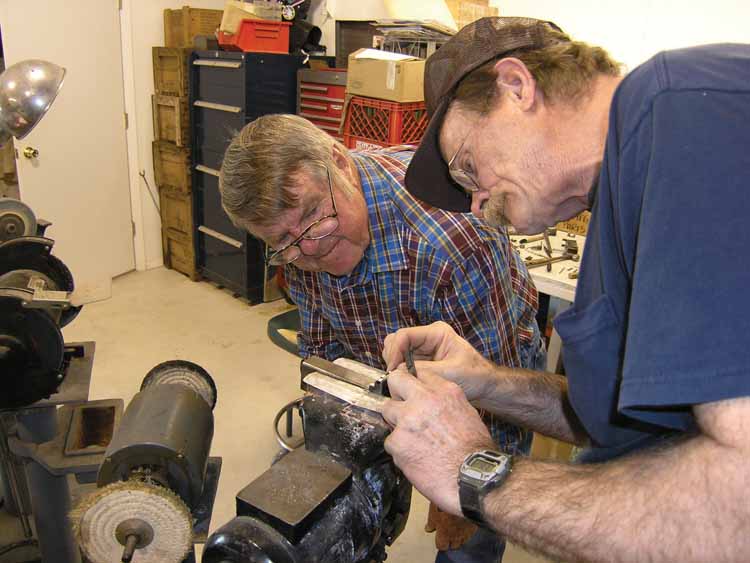
A team was immediately assembled including John Mathis, Scott Andrey Machine Works for barrels, Dan King for testing and application work and Byron Starnes for design and fitting of the numerous small parts unique to the design. The parts that were non-proprietary were located and purchased and modifications began.
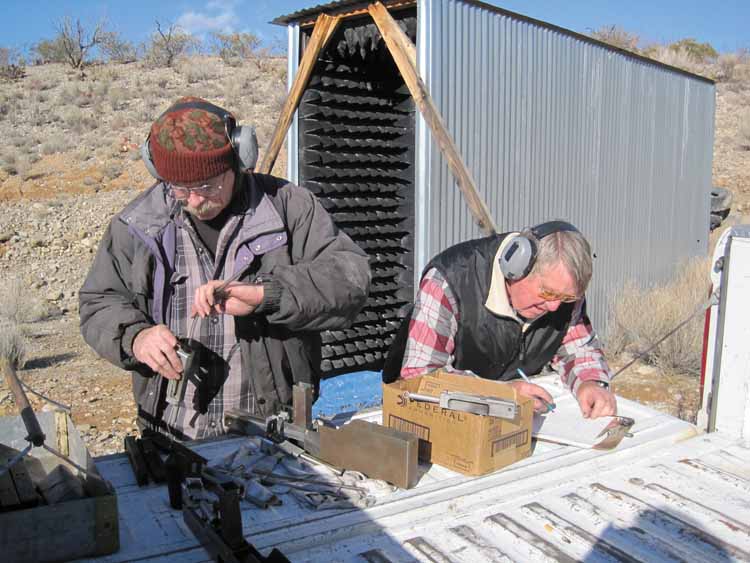
The New and Improved UC-9
As the project moved ahead it was recognized that some outward aesthetics needed to be employed in order to stay with the original idea of being hidden in plain sight. The earlier “boom box” style radios have been long out of style and anything resembling them at this point would attract more attention than they would blend in. The telescoping antenna would be removed and the large “carry handle” would also have to go. The swivels and studs were removed and the box was given a much more streamlined look. With the loss of the carry handle a new sighting system would need to be designed. Taking advantage of technology that did not exist when Conner developed the first gun, a miniature laser was mounted inside the gun when folded but immediately accessible when deployed. The grip / magazine-well was redesigned so it would automatically close inside the folded configuration and made it easier to close the gun after use. A safety was added to the design and the original “open sear” design was improved as well.
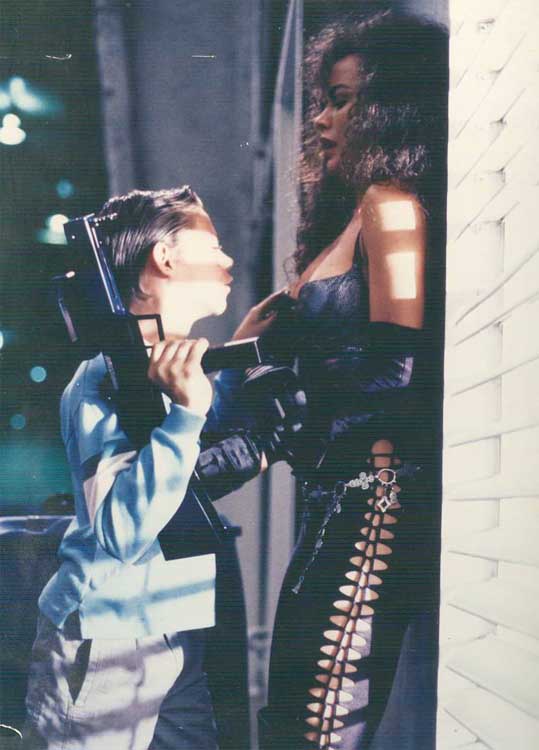
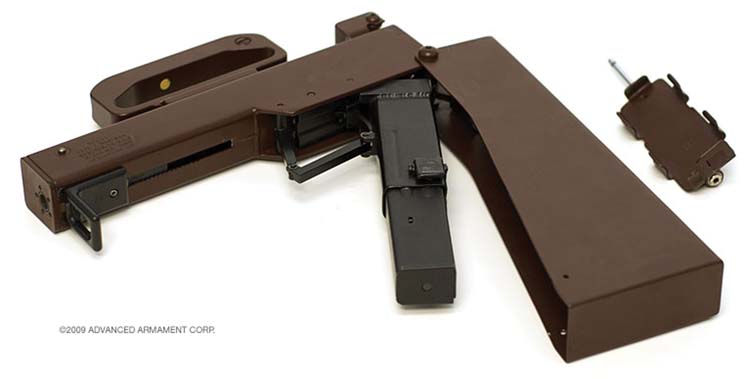
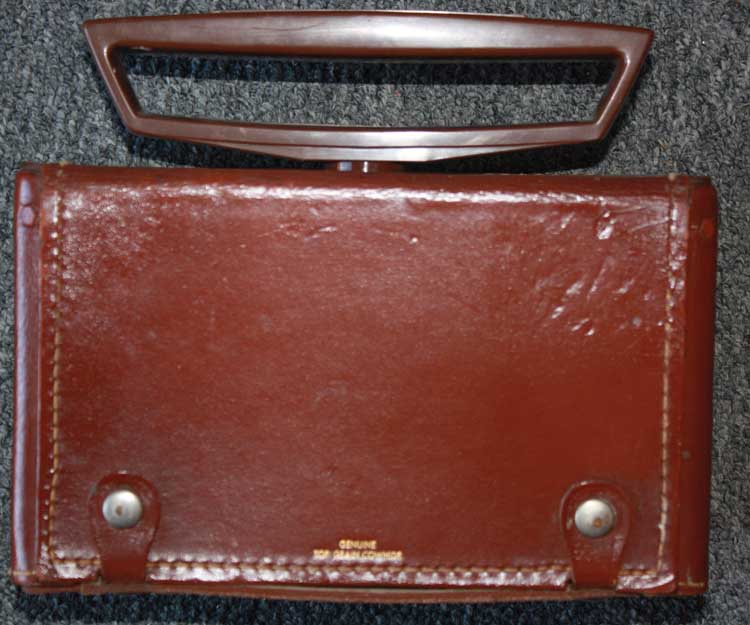
The last outward change that was necessary to redesign was the large exterior latch that secured the rear portion of the buttstock that locks everything together securely when opened for use. An internal latch was designed and had no outward indicators visible.
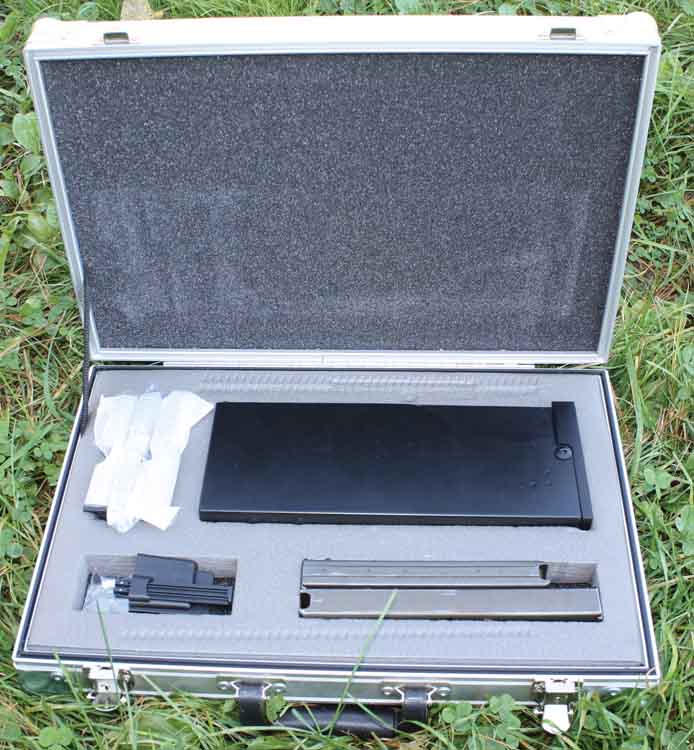
At times an early design can beat any amount of reengineering and the end cap / dust cover that holds the folded unit together is a perfect example. When the gun is opened for deployment the end cap drops to the ground and it was thought a tether or lanyard of some type would be better than having a part drop to the ground. Before spending too much time on this “improvement” it was discovered that the cap falling to the ground was serving a purpose that could not be retained by stopping it from doing so. As originally designed, when the gun is opened quickly for deployment and the end cap pops off and falls to the ground is serves as a distraction, both visual and in an audible fashion. This momentary distraction can buy the user precious time when it is the most important.
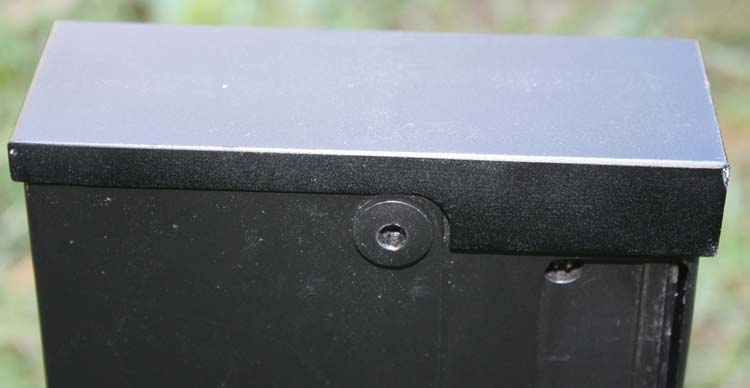
When the 6-month timeline rolled around and things were moving well, but far from completion, Michael Shyne could remember the important statement Utah Conner made during a conversation very early on: “Michael, you don’t know how much work is involved.”
Ready to Roll
Today the UC-9 is finished and in stock. There are several still available and they present an interesting “new” NFA firearm with a long and interesting history. The UC-9 feeds from unmodified UZI magazines, both 25-round and 32-round versions. Since the original “boom box” features have been removed it is wide open to blend in to many modern settings. With a faux, stick-on USB port they resemble an external computer backup drive and hide in plain sight on a desk. With a book spine glued to the top it could be stored in a bookcase and never earn a second glance. A few stickers from a hardware story and it may look like a travel tool kit. It is as open to adaptation as the imagination of the owner.
All UC-9 SMGs are shipped with a LULA magazine loader and a 39-page owner’s manual in a custom fit aluminum case manufactured by Americase.
Open Wide and Say BANG!
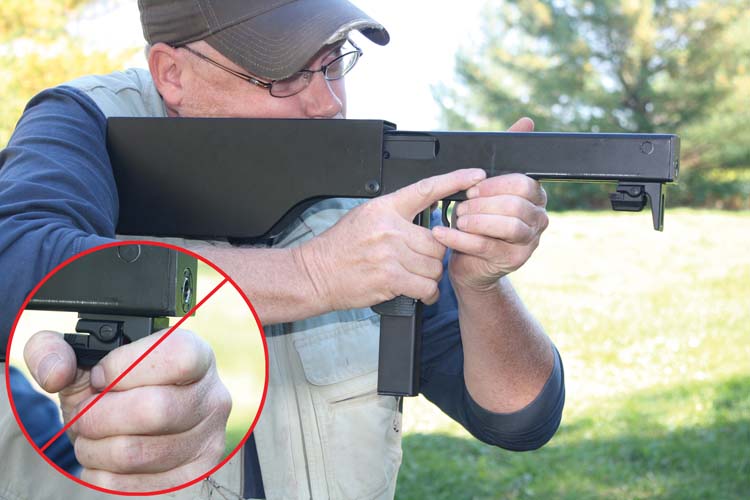
With nothing really protruding or obvious as a “release button,” preparing the UC-9 for firing has the outward appearance of solving a puzzle more so than readying a submachine gun. This adds to the beauty of the new, sleek design in respect to it not being identifiable and the process once explained and witnessed is actually a smooth and fluid motion. The instructions to open the UC-9 vary by the strong shooting side. I will give the instructions for a right-handed shooter and you lefties can adjust accordingly.
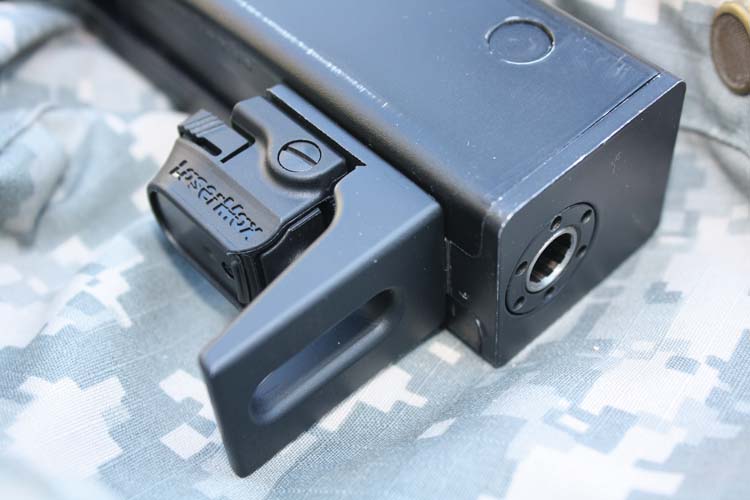
(1) To open the UC-9, holding it with the dist cover up, place your right hand on the lower portion of the buttstock and left hand on the upper receiver. (2) As you hold tight and extend your arms it will unfold, releasing the dust cover. (3) As it is unfolded and begins to take shape, when the receiver is in line with the stock it will lock in the open position. (4) At this point the magazine well / pistol grip will start to drop into position. (5) Supporting the weight of the UC-9 with the left hand, as you move the stock to the right shoulder, the right hand should wrap around the pistol grip and rotate it rearward until it locks into place. There you have it. From a nondescript rectangular block to a shouldered SMG in seconds, the UC-9 is ready to fire.
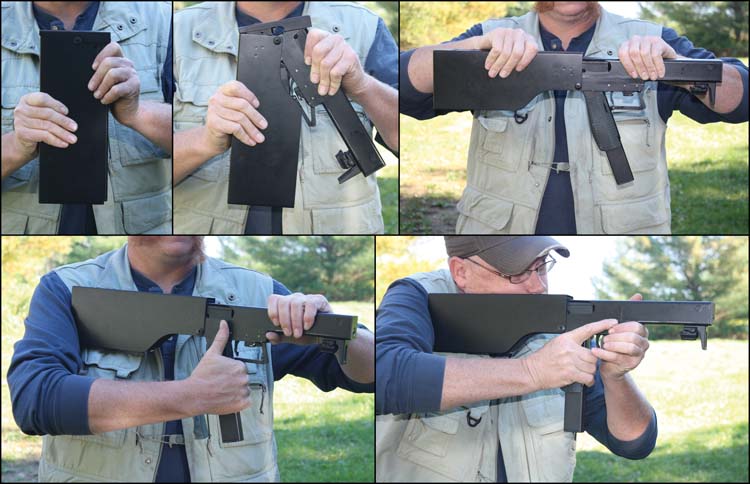
If you are indeed ready to fire the UC-9, all that needs to be done is pull the charging handle to the rear locking the bolt back. More often than not the laser directly behind the charging handle will be turned on with this motion and with very little practice it can turn on every time if desired. It is important to know that the charging handle does not pull double duty as a forward pistol grip. If your hand were to stay on the charging handle it would be much too close to the muzzle and also cover the laser sight. The proper place to support the UC-9 with your left hand is in front of the pistol grip, forward of the ejection port
Time for Live Fire
Of course we could never have an article on an NFA firearm as interesting as the UC-9 without firing it and reporting our findings. It is not common enough to have a “new” transferable submachine gun to pass up the opportunity.
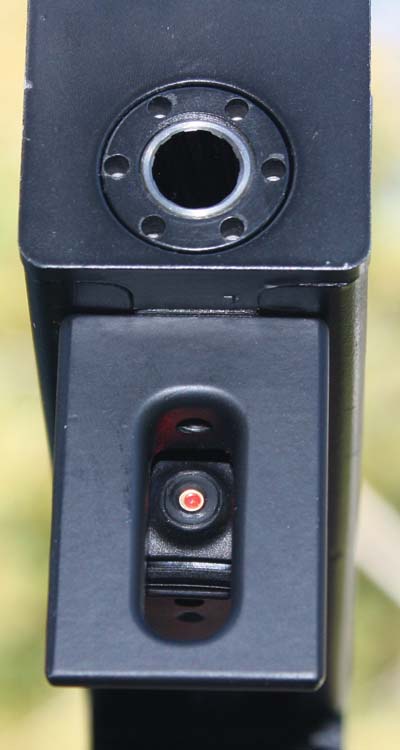
Since the design is radically different from most common firearms the first task was an overview of the operation of the UC-9 and a review of the owner’s manual so everyone would be familiar with the use and procedures. After some extensive handling it was obvious that it was as much fun to share with new people and watch their face when deploying it, as it was to fire. There are no machine guns this writer has tested in over 2 decades that were as much fun to handle as they were to shoot so this is a first.
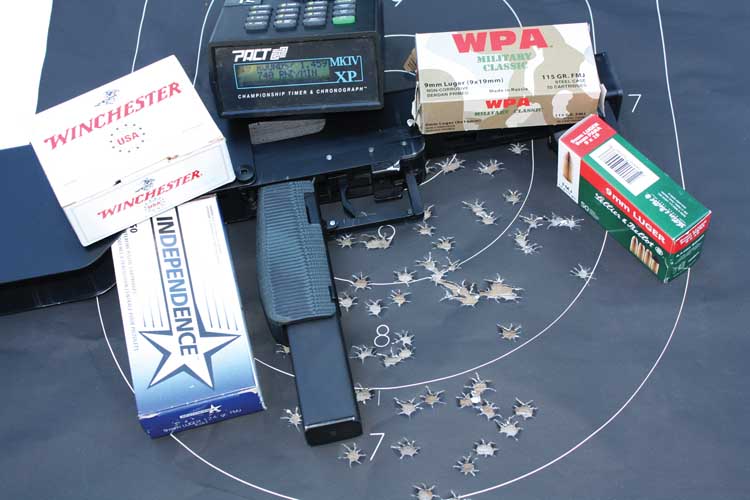
The way the UC-9 is manufactured it can safely be carried with a loaded magazine in a “ready to deploy” manner. Even though the magazine is loaded and inserted into the magazine-well, it is folded in a way it is stored parallel to the barrel and doesn’t drop into position until the gun is deployed. In addition, since it is an open-bolt firing mechanism, stored with the bolt closed it is not possible for a round to enter the chamber in a closed position. With this said, all it takes to safely load and fire the UC-9 is to hold the top with one hand, pull the stock with the other (as illustrated in this article), and pull the mag-well to latch. When you pull back the bolt you have a tendency to turn on the laser at the same time, so within seconds this innocuous rectangle transforms into a loaded, laser-sighted SMG, ready to roll. (DISCLAIMER – Even though the UC-9 was designed for undercover, instantaneous use, there is not a manufacturer or lawyer in the United States that would allow an owner’s manual to suggest loading a gun immediately prior to using it. Please remember that we live in a nation that has warning labels on hair-dryers so people swimming in the shallow end of the “good decision making” pool will not use it while taking a bath. Please adhere to all safety rules associated with any other firearm when using the UC-9.)
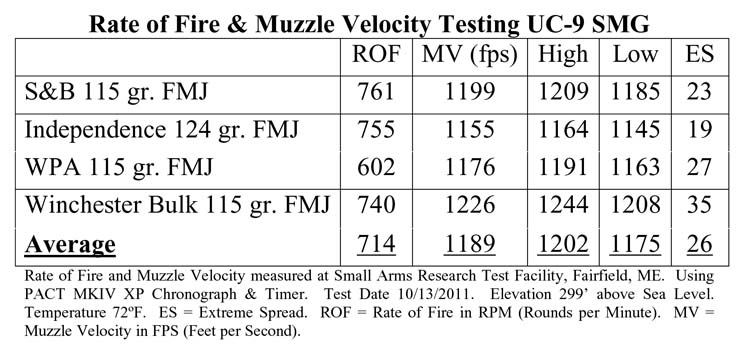
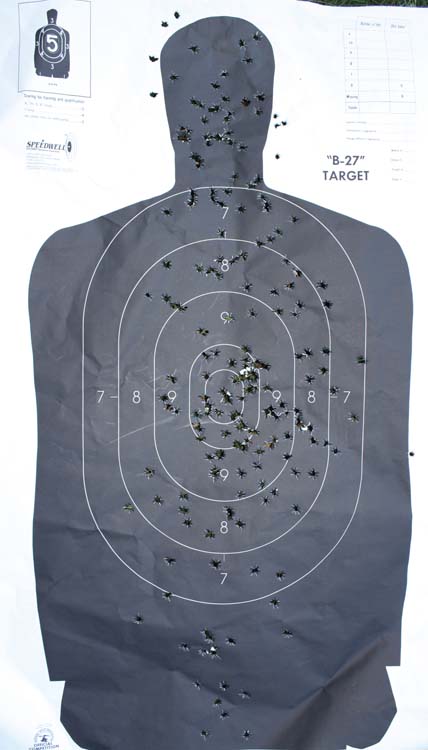
The live fire portion of the UC-9 testing started with some basic function testing and weapon system familiarity. This consisted of the test shooters firing several magazines using the laser as an aiming device. (You can be certain that since we were to be running rounds through the author’s IR Chronograph Screens to check muzzle velocity later in the day, everyone would be familiar with proper aiming technique in advance.)
After everyone was comfortable with shooting the UC-9 we set up the PACT MK IV Champion Chronograph and Timer and started recording the rate of fire with different types of ammunition. We tested the UC-9 with 4 types of ammo to gather as much data as possible. The average rate of fire was very comfortable and just under 715 rounds per minute. The slowest we recorded was with the new Wolf Performance Ammunition WPA 115-gr at 602 rpm. The complete results are documented in an accompanying chart.
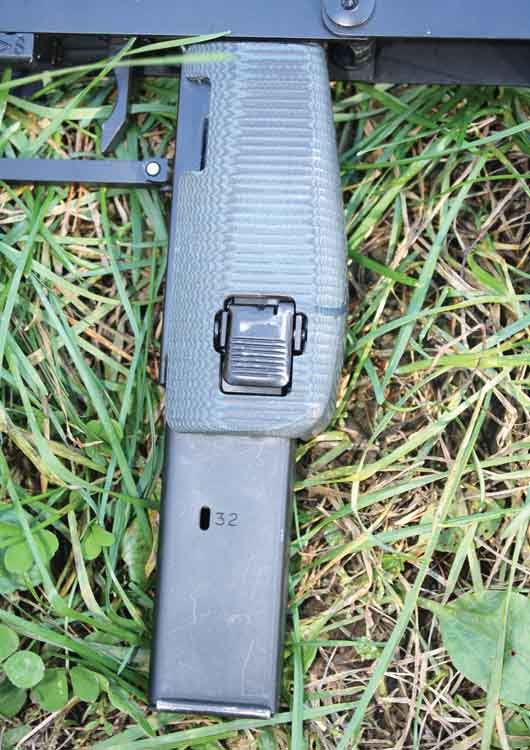
This was also a great time to check practical accuracy. We set up at 10 yards and started firing 20-round bursts at standard silhouette targets. Although it is unlikely that complete mag-dumps on a single target would be a standard procedure, it proved how controllable and comfortable the UC-9 was to shoot. After firing several hundred rounds during this phase at a single target it was apparent how effective the UC-9 can be. Both shoulder firing and hip firing were used, at the shooters discretion, both with remarkable results.
When in bright light conditions where a laser is ineffective and given the absence of sights, the aiming technique is something a little different than most are used to and requires a little practice to master. It is not practical to shoulder the gun and sight down the plane of the receiver because the stock portion of the gun is held well below the muzzle to achieve a proper cheek weld when sighting in this way. If you were to aim the end muzzle end of the receiver so it lined up with the intended target, the plane of the barrel would be rotated up several degrees causing your hits to be VERY high. Based on your distance it could be from several inches to several feet. The cure for this is just practice, practice, and more practice. Holding a proper cheek weld but looking over the top of the muzzle end of the receiver at your target area, you can develop a “point shoot aiming method” that can be surprisingly accurate. By doing this numerous times at a known distance you can train your eyes to triangulate the proper hold with no sight use at all. It will not be an effective “sniper” or “match” gun but these are areas far from the original intention of the designers.
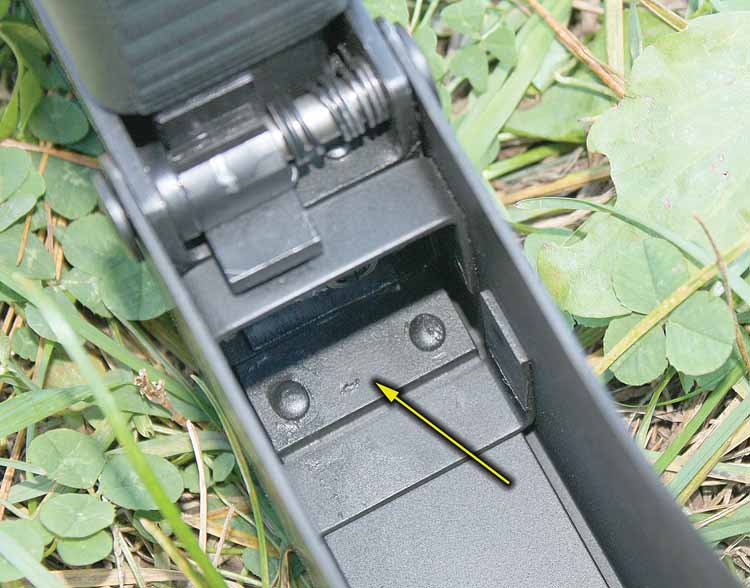
After plenty of practice runs, we ran numerous rounds through the UC-9 to get a good picture of average muzzle velocities. The average muzzle velocity was 1,189 feet per second. The fastest was the Winchester “White Box” 115-gr. FMJ ammo at 1,226 fps. A detailed chart with all data recorded is included elsewhere in this article.
There were two distinct things that all shooters mentioned after firing the UC-9. The first was their amazement at how smooth and controllable it felt during live-fire. The second was that while the charging handle is a non-reciprocating design, it does have a small amount of travel on occasion probably due to a light amount of friction from the vibration that allows it to briefly contact the bolt. It isn’t forceful or painful at all but was a surprise to those not expecting it.
Closed for Business
If you believe that at this point you have mastered the techniques associated with the UC-9 we have one more important part to explore. Now that it is open and looks (sort of) like a submachine gun, we need to fold it back up to its original, nondescript design. This would prove to be a hurdle for all not previously shown the instructions in the previous section.
The easiest way to complete the proper folding sequence is to first examine the placement of the “press point” rather than try to guess or feel around for it. We will make it simple by explaining where it is and providing a clear photo as well. The “press point” is located inside the stock where it connects to the receiver. It is designed so well it will still not be obvious by the previous description alone. To tell it apart from the rest of the stock or receiver you need to look inside the stock against the receiver for a flat surface with 2 rivets. This is the “press point” and depressing it will unlock the stock from being fully extended and start the folding procedure. With this knowledge, please follow along to the next step.
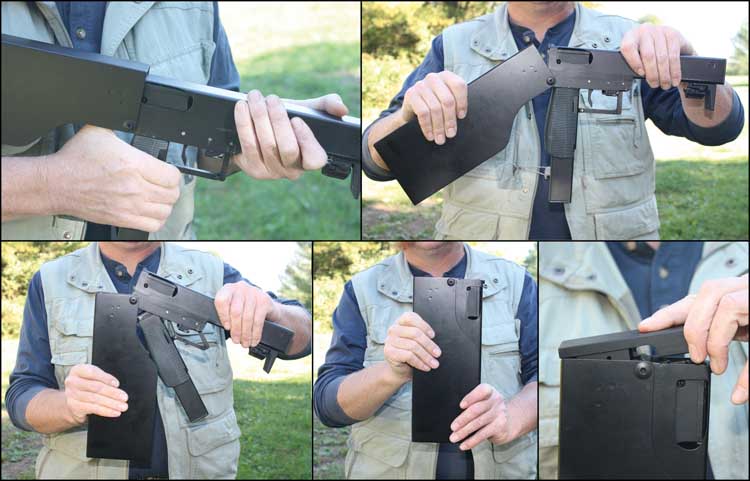
With the UC-9 in a position where it is supported by your left hand and the stock is in the area of your right shoulder (1) you can reach your thumb up past the end of the pistol grip and depress the “press point” with little practice. It is important to hold the UC-9 upright to close it, not upside-down looking into the hollow stock cavity. The next step (2) is to hold the stock with your right hand, and holding it in a position so the now empty dust cover slot is open is up, slowly fold the 2 sides together. The pistol grip will freely swing down (3) if this is being done correctly and you will feel little or no resistance. When completely closed (4) the dust cover can be installed (5) by placing the angled lip on the bottom of the dust cover into the slot on the buttstock and pushing down firmly to lock it in place. It is now ready to be hidden in plain sight again and only seconds from use.
How Hidden is Hidden?
The first test all who were in the writers office at the same time as the UC-9 were subjected to was a simple “pass me that machine gun” statement while pointing to the bookcase. It just sat sideways, across the top of one row of books with nothing to conceal it. Everyone would glance at the bookcase and then start to look around it for something that looked like a submachine gun. Even by doing nothing special it blends in and that is with people looking for a gun. This speaks volumes, no pun intended.
Conclusions
The UC-9 is one of the most interesting pieces this writer has had the opportunity to test and share with the readers of Small Arms Review to date. That is not said lightly either. We have covered several aspects of the gun culture here and they are all equally important. There is a fantastic historical aspect to this gun that has not been completely reported in the past to our knowledge and if we don’t examine our own history in this industry we are doomed to repeat things that may be unnecessary in order to advance. The relationships of those who brought us the UC-9 are fascinating to say the least. It is a story of completely unrelated parallel designs happening at the same time between Utah Conner of Pearl Manufacturing with his Model 21 and Francis Warin of ARES Incorporated with their ARES FMG. Some of the others involved in different areas including Eugene Stoner, Tim Bixler and Dave Boatman are names we recognize from other projects they have been involved in, within the firearms industry and all bring a lot of experience to the end projects. Another interesting aspect of this study is the tie to Hollywood with the RoboCop 2 Radio Gun placement. Never knowing what is fact and what is fiction or special effects in the movies, it is always amazing to find out that something as neat and “far fetched” as a boom-box radio that almost instantly transforms into a submachine gun is in the “fact” category. Another angle that makes this article a little more exciting than a simple historical piece is that these UC-9 submachine guns are actually transferable machine guns and are available for sale at this time. We have reported over the years of several “after the fact” treasures, but this one is a little ahead of the curve for a change. Finally, it just pegs the “neat meter” at 11. I doubt there are many of us, regardless of our specific discipline or area of NFA interest who doesn’t smile a little at the notion of this creative, folding, covert submachine gun.
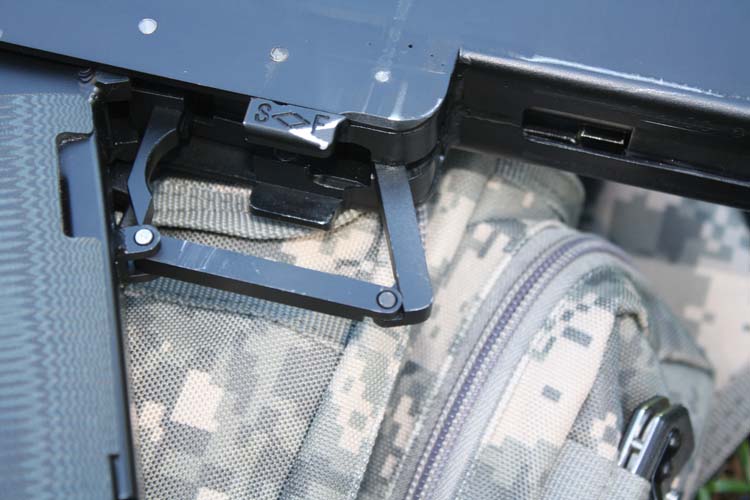
Aside from all the other important aspects of the UC-9 project previously mentioned, the gun is fun and functions well. It is very well made and looks great. All mechanisms relating to the function and concealment work like they should. This is not a “work in progress” but a final product in full form. The UC-9 SMGs are currently available and the numbers are in the low high 40s to low 50s at the time of this writing. At a cost of $12,500 with owner financing available directly from M6 Management Corporation, those numbers are sure to be dropping at a rapid pace. Whether you may be interested in one as an investment, as a part of history, as a Hollywood film fan or as a closet “super secret squirrel spy gadget” aficionado, the UC-9 is certain to make you smile when you receive yours.
UC-9 SMG Source
Full Auto Classics
Ph: (877) 437-0251
Email: sales@fullautoclassics.com
Website: www.FullAutoClassics.com
| This article first appeared in Small Arms Review V15N4 (January 2012) |










